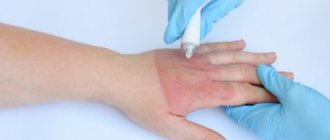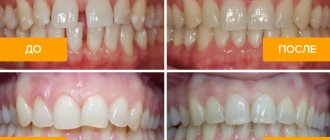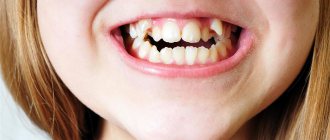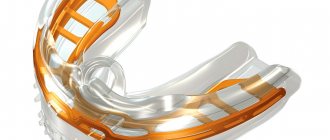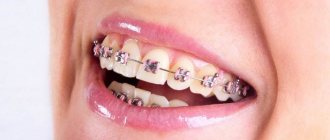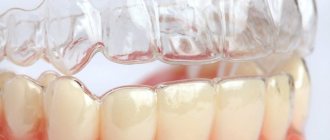Features of braces Indications for braces Features of aligners Indications for aligners Differences between braces and aligners Which is faster?
Comparison Pros and cons Cost Modern orthodontics offers very extensive opportunities in the field of bite correction and teeth alignment. Technologies are expanding and improving, and orthodontic systems are becoming more invisible and comfortable. Today, braces or aligners are used for treatment. Both technologies effectively cope with almost any orthodontic abnormality. Each has its own pros and cons. The principle of treatment differs little between the methods; the main difference between aligners and braces is aesthetics and ease of wearing.
What are braces?
A brace system is a non-removable orthopedic device consisting of clasps with grooves (braces), an arch that combines these clasps into a single mechanism, additional elements - elastics, ligatures, and an arch is passed through the grooves. The principle of operation lies in the ability of a metal arc to take its original shape. Straightening up, she pulls the locks behind her, pulling the teeth into the required position. The result is stabilized with fixed or removable retention devices.
Bracket systems differ in design - they are ligature, self-ligating, vestibular, lingual. They are made from a variety of materials: metal alloys (including gold), polycrystalline ceramics, synthetic sapphires. Devices made of metal have no equal in strength; the most aesthetically pleasing are ceramic and sapphire. When choosing which is better, aligners or braces for straightening teeth, you take into account not only the aesthetic side. The main thing to start from is the capabilities of the system in a particular case.
Is it possible to straighten teeth without braces?
When planning a treatment program, the doctor always takes into account not only the characteristics of the clinical case and the degree of complexity of the existing problem, but also a number of individual characteristics of the individual:
- the age of the patient and the goal he wants to achieve;
- his attitude towards his own health;
- degree of motivation for long-term treatment;
- and even temperament, which determines the ability to methodically follow all the orthodontist’s recommendations for a long time.
With this approach, the bracket system very often turns out to be the most effective and fast-acting option. Since it is worn constantly, even in the most difficult cases, the bite after braces becomes correct. For many patients, this choice is also justified by the fact that they do not have to do anything on their own with locks on their teeth. And the appearance in Moscow made the correction unnoticeable.
But if the doctor sees that a beautiful smile with lasting results can be created with aligners, they will certainly be used, in agreement with the patient. What are the nuances of correcting a bite without braces?
When are braces installed?
- Bite disorders of any nature or complexity;
- crowded teeth;
- disproportion of jaws (one is less developed);
- dental anomalies;
- incorrect position of the dental unit (curvature, rotation around an axis);
- removal of an unerupted tooth;
- upcoming prosthetics, implantation.
Treatment with ligature devices will take 2.5-3 years
, self-ligating -
1.5-2 years
. The duration of the adjustment depends on the clinical features and system model.
Advantages of braces systems
Braces are noticeable on the teeth when smiling and while talking, and this is one of their main disadvantages. They can cause inconvenience and a feeling of embarrassment and require adaptation and careful care. But their effectiveness easily covers these shortcomings. This technique has many advantages:
- braces are more rigid and exert strong pressure on the teeth, increasing the effectiveness of correction and accelerating the result;
- suitable for correcting dental anomalies in complex cases, where aligners are powerless;
- suitable for adults and children.
But even with their high effectiveness, the patient will have to visit the doctor repeatedly and on a regular basis, and treatment can last from several months to several years.
To minimize the aesthetic defect during treatment, you can use ceramic, sapphire or ligature braces, which are installed on the inside of the teeth. They are not so noticeable, but it is impossible to completely hide them. In addition, ligature systems may not be used in all clinical cases.
When wearing braces, you will have to comply with serious dietary restrictions. It is necessary to avoid or minimize the presence in the diet of foods that are too hard, hard and stick to the teeth.
Braces require more careful oral hygiene. The patient needs to brush not only his teeth, but also scrupulously clean all structural elements where food particles may become clogged. Otherwise, plaque will be deposited in hard-to-reach places and cause bad breath, the development of dental diseases, and caries.
Aligners: what are these devices?
Aligners are transparent orthodontic trays made of thermoplastic polymer composite. The difference between braces and aligners is that the pressure on the dental units is not exerted by clasps connected by an arc, but by special activators inside the device, which set the impulse to shift the dental unit. To achieve the desired results, a set of correctors is made of different thicknesses, shapes, and sizes.
Each pair is created taking into account the predicted trajectory of displacement of the dental unit to a given position. The aligners change sequentially from larger to smaller sizes (every 2 weeks). All aligners in the set are numbered, so the patient knows exactly which system to use at a certain period. Wear the corrective device for 20-22 hours
per day, every day, removing only for food and hygiene care.
Those who want to choose aligners instead of braces need to think carefully about how responsibly they treat treatment. Corrective devices often cause discomfort and pain, especially when changing the arch or cap. And if it is impossible to remove the bracket system and you have to endure adaptation, then the aligners can be removed at any time or “forgot” to put them on. This increases the correction time, and often reduces treatment to zero. Therefore, aligners are suitable only for patients who are truly motivated to achieve results. For those whose self-discipline is lacking, it is better to choose braces.
Visible when smiling or not
An alternative to braces - aligners - are actually practically invisible on your teeth, and none of the people around you will guess that you are undergoing orthodontic treatment. Of course, unless they are practicing orthodontists. Preference is given to aligners, primarily for aesthetic reasons. It is more difficult for patients in adulthood to change their habits. Treatment without braces fits perfectly into their daily lives. In addition, an alternative to braces - aligners - moves teeth very delicately, which is very important not only for adult patients, but also for teenage patients.
When are aligners installed?
- Trema, diastema;
- crowding of teeth (up to 6 mm);
- shortening or lengthening of the incisors (vertical anomalies of occlusion);
- rotation (wrong position) of the dental unit;
- the tooth deviates forward and backward;
- upcoming prosthetics or implantation.
The duration of treatment with aligners depends on the severity of the disorder. The course of correction can take from 8 months to 2 years or more. Each design has an individually specified trajectory of the action of weak forces on the dental units. One device displaces an abnormally located tooth by 0.2-0.3 mm. How many correctors are required for a set depends on the situation - the simpler the problem, the fewer aligners are needed.
The first pair of devices corresponds to the initial clinical picture; each subsequent pair includes adjustments to change the position of the teeth. The last pair displays the treatment result.
Treatment results before and 6 months after:
Patient 27 years old Diagnosis: crowding of teeth 6 months after the start of treatment: improvement in the position of the incisors on the upper and lower jaws, expansion of the jaws, distalization of the canines Treatment: with aligners Duration of treatment: 6 months, during treatment Treating orthodontist: Olga Nikolaevna Plink
What is the difference between braces and aligners?
Both correctors are designed for the same task: they correct occlusion and make the dentition straight. The principle of operation of the structures is identical - moving dental units to a given point, but the similarity ends there.
- The bracket system acts on the dentition using locks and a tension arc, and the aligners create an impulse to shift the tooth with special activators.
- Braces are a non-removable system that is installed for the entire course of treatment, aligners are removable devices that the patient can remove and install independently.
- Orthodontic aligners do not interfere with your usual lifestyle and diet; when using braces, there are certain dietary restrictions.
- Maintaining the hygiene of biopolymer aligners is easier than cleaning a bracket system consisting of many elements.
- Elements of braces can injure the mucous membrane and interfere with closure; the functions of the tongue, created from elastic inert thermoplastic aligners, do not have these disadvantages.
- Locks with an arc are conspicuous (except for lingual systems); mouthguards made of transparent material are almost impossible to see from the outside.
When choosing aligners or braces to straighten your teeth, it is impossible to say for sure which will be better. Not in every clinical situation, mouth guards are the most effective, but they undoubtedly lead in terms of comfort. For each situation, the dentist will offer several treatment options, and the patient will choose the optimal one in terms of price, aesthetics and functionality.
What parents need to pay attention to
Ages 3 to 6 years
It is necessary to pay attention to early signs that contribute to the occurrence of improper development of teeth and dentition.
Let us list the points that help a child’s teeth grow crooked:
- early loss of baby teeth,
- breathing disorders,
- closing of the child's lips during sleep,
- sluggish, slow chewing and swallowing,
- speech disorders,
- poor posture,
- bad habits - sucking fingers, tongue, objects.
When studying the survey data, it was revealed that the majority of patients (95%
) were referred to an orthodontist after 6 years.
I don’t doubt for a second that if you knew that your child could develop a malocclusion, you would immediately begin to follow the doctor’s advice: change your diet, eliminate bad habits, and perform therapeutic exercises. This relates to the question of how early you should see an orthodontist.
Why do something now, when it’s already clear that “the teeth are crooked, when they grow, then we’ll put braces on him”
In the modern world, orthodontics plays a huge role. The desire for a beautiful, even smile, the desire to have snow-white, straight teeth becomes the norm of life. Thus, it is obvious that by referring children in early childhood to an orthodontist, who can give professional advice on the prevention of dental anomalies, it is possible to prevent the formation of malocclusion in children. And avoid dental problems in adulthood.
My doctoral daily practice in communicating with children and parents shows a fairly good awareness of orthodontic treatment methods. About the existence of dental plates and braces
, we don’t have to talk about trainers for a long time - these types of orthodontic structures are the most common, widely known to both the small and adult population.
Early treatment takes advantage of progressive, irreversible tissue changes during tooth growth and eruption, targeting them to stop the development of the anomaly before significant dental and morphological compensation occurs.
The main task facing the orthodontist is the following: it is necessary to give the teeth the correct vector of development
, create conditions around the teeth for their optimal growth!
Dear friends, in early childhood, the orthodontist, together with the parents, is the coordinator of the correction of dental anomalies that form during the period of active growth of the child’s teeth. The consequences of inaction - that is, waiting until the child grows up and you install permanent braces or any other aggressive devices - are more difficult to treat and retain, and maintain the achieved result.
By using early orthodontic treatment, you and I have the unique ability to manage tooth eruption to minimize the need for future tooth movement.
Why are records needed?
Most practicing orthodontists find it difficult to determine exactly when it is worth interfering with the formation of malocclusion, and when Nature should still “do its thing.” This is because experience only comes after years of careful observation, and the decision to intervene is often driven by parental demands to “do something.”
Orthodontic care for a child consists of the use of preventive and therapeutic measures - myogymnastics, hardware and surgical treatment. The most common of them is the hardware method.
A dental plate is a passive removable orthodontic device, and if a screw or various spring elements are added, the design becomes an orthodontic device with active mechanical action. The activity and strength of the device depends on how many millimeters the doctor has extended and activated the spring, tightened the screw, etc. The fulcrum in them is the teeth and the alveolar process under the base, the regulating active part is a screw, a spring, and the clasp is a fixing part.
How to sleep with dental plaques, will my child swallow them at night while sleeping?
There is no reason to panic, dear friends, the orthodontic device (plate) in the correct individual high-quality production is sufficiently tightly fixed due to the hooking metal elements, as well as the anatomical shape.
When putting on the dental plate, you can hear a characteristic click - this is a positive thing. It is very important to properly remove and put the plates on your child’s teeth so as not to bend their wire elements, and also carefully monitor their cleanliness and maintain hygiene.
Straightening teeth with aligners or braces: which corrects defects faster?
The effectiveness of modern corrective devices is almost the same, but in some clinical cases it is not advisable to install aligners. This applies to severe, sagittal malocclusions, in which corpus movement of the dental units is necessary. Braces can deal with such defects faster and more effectively. Usually treatment with braces takes 1.5-3 years
(depending on the model, initial clinical picture). Self-ligating systems work faster than ligature systems.
Aligners can correct almost any anomaly, but correcting complex defects requires a lot of time and a large number of aligners, which will significantly increase the cost of treatment. Typically, treatment with orthodontic aligners takes from 6 months to 2 years
.
It is impossible to answer unequivocally what is more effective. The orthodontist will comprehensively assess the situation, based on the results of the examination, photographs, the condition of the teeth, and recommend mouth guards or braces to straighten the teeth. The best option is the one that is most suitable for solving a specific problem.
Range
Manufacturers offer a large selection of high-quality aligners; there are no significant differences between them. All products are manufactured using high-quality polymer materials that are absolutely biocompatible and hypoallergenic. The models differ only in the equipment and software used in their development and release. Also, much depends on the qualifications and skill level of specialists working in dental laboratories and in production.
Some companies set a fixed price for mouth guards, and some pay for the entire treatment at once. Depending on which clinic you went to and which brand of onlays you chose, the final cost of correcting your bite may vary. At the moment, there are several well-known brands whose main activity is the creation of innovative orthodontic devices. Invisalign products were the first to appear on the market and are still produced in the USA to this day. They are considered the most expensive, but they allow you to cope with even serious pathologies in the shortest possible time.
AirAlign are produced in Italy and are an excellent budget analogue to the previous option. Star Smile, 3D Smile, Orthosnap and VSD are created in Russia and cost less due to the absence of large transportation costs. New laboratories are opened annually, so the range is constantly updated. If you choose a good orthodontist, then there will be no need to delve into the differences between all these models. He will definitely tell you about all the nuances and select the optimal solution, taking into account the clinical picture and the available budget.
Comparison of aligners and braces
| Braces | Mouthguards | |
| Predicting the result of the adjustment | Approximate planning taking into account dental mechanics | The patient sees the exact result at the 3D planning stage |
| Aesthetics | Noticeable when talking, smiling (except for lingual models) | Invisible to others even close up (face-to-face) |
| Removable\non-removable | Only an orthodontist can install and remove braces. | The patient removes and installs the corrector himself |
| Comfort | The design of locks, clamps, additional elements can injure the mucous membrane, impair sound pronunciation during the adaptation period, there are dietary restrictions | Invisible, flexible, lightweight biopolymer devices, do not affect diction, do not require a change in diet, and are easy to maintain |
| Enamel injury | Under the locks, demineralization is common, the accumulation of bacterial plaque under the tension arc, between the locks contributes to caries | Does not injure the enamel layer or soft tissues; plaque from the surface is easily removed with a regular toothbrush |
| How often should you visit the orthodontist? | To activate ligature devices, a doctor is visited every 3-4 weeks, self-ligating devices - every 2-2.5 months. | every 2-3 months |
What are the advantages of aligners?
Many of the benefits have been mentioned above. In general, they work on much the same principle as braces. By applying constant pressure to incorrectly positioned teeth, mouth guards move them in the desired direction. At the same time, the bone tissue is absorbed in the right places, firmly fixing the teeth and preventing them from returning.
One of the main advantages of aligners is their aesthetics. For many people this criterion is key. They are very thin and transparent. Almost invisible on the teeth, even up close. Convenience of treatment is another plus in the collection of overhead mouth guards. They are almost not felt in the mouth, unlike braces. Also, you don’t need to get used to them for a long time, and they also have a very soft effect due to the ideal smoothness of the surface. The tongue, mucous and bone tissues are not injured.
The material from which the aligners are made is completely compatible with the tissues of the human body. It is hygienic and hypoallergenic. In the case of braces, allergic reactions are rare, but they do occur.
Braces are much more difficult to maintain than aligners. To clean them, you do not need to buy a special brush or brush. You can get by with your usual toothpaste and brush. The only peculiarity is that teeth and aligners need to be cared for separately.
For aligners, the prognosis and result are calculated by a computer, which produces an accurate result. Even during preparation, the patient understands what he will receive in the end - how many pairs of aligners and how often they will need to be changed, as well as how long the treatment will last.
Pros and cons of aligners and braces
- After fixing the bracket system, it takes about 2-3 weeks to get used to the structure. The adaptation period is accompanied by discomfort in the mouth, injury to the mucous membrane, and changes in sound pronunciation. Adaptation to the aligners is faster and causes minimal discomfort.
- Orthodontic aligners are removed while eating, so there is no need to change your eating habits. Wearing permanent braces requires certain dietary restrictions.
- Compared to braces, transparent aligners are more aesthetically pleasing because they are completely invisible on the teeth, but in some clinical cases their installation is ineffective. If corpus movement of teeth is necessary, a brace system can handle it faster and easier. Correcting a similar problem with aligners will take much longer.
- Braces are more demanding in terms of care; using aligning trays, hygiene is carried out in a standard manner.
- The cost of metal braces is much lower than the price of aligners. Models made of sapphire or ceramic are almost identical in price to mouthguards.
- When used correctly, both systems effectively solve bite problems.
An example of treatment using a brace system at the ROOTT clinic
How we tested bite correction with aligners on our director
What are aligners
Aligners are transparent and almost invisible from the side of the tray, which are worn on the teeth for everyday wear and correct the incorrect position of the teeth, which was previously considered the prerogative of braces.
Clear aligner
A little history
The history of transparent aligners began in the distant nineties - it was then that, having registered in 1997 and received all the necessary licenses in 1998, by 1999 Align Technology began selling its Invisalign system to American orthodontists. Already in 2000, the company launched a full-scale advertising campaign for patients, and by the end of 2001 it entered the European market, producing at least a million drops. By mid-2003, the Invisalign system began to be introduced as part of the training of future dentists in medical schools, and since then has been spreading non-stop throughout the world.
Comparative pros and cons of aligners and braces
Of course, braces have their advantages.
Braces are the most effective tool in the hands of an orthodontist, since their action is based on the force developed by a metal arch. In addition, the design of the bracket system allows it to be combined with various additional elements, thereby significantly expanding the range of tooth movement in all planes.
It is also important here that braces are the most controlled tool in the hands of a doctor, since the specialist carries out all manipulations independently, leaving no room for error for the patient. After all, the patient can remove the aligners uncontrollably. The relative cheapness of bracket systems also matters.
In some cases, aligners may be powerless; braces are the most powerful remedy.
Aligners, of course, have disadvantages, for example: narrower indications for clinical use compared to braces, due to the design features of the aligners. Aligners are a gentler treatment. An undoubted disadvantage is the dependence of the result on the responsible approach of the patient and his compliance with the doctor’s recommendations, as well as the need for additional impressions and modeling of new aligners, if it is necessary to adjust the impact of the aligners during wear. And a higher cost, especially if the aligners are ordered from abroad.
The main reason for such an explosive expansion of Invisalign is the extreme convenience of aligners compared to braces. Unlike braces, they do not injure the oral cavity with metal parts - after all, they do not have such parts.
Braces injure the mucous membranes.
They do not damage the tooth enamel with plates - there is no need to glue metal or ceramic plates to the teeth, there are only locks made of biocompatible plastic, which are gentler on the enamel, and you need much less of them - not for every tooth.
Braces can seriously damage teeth: in addition to the destructive effects of metal, there is also such a harmful factor as the impossibility of normal teeth cleaning - the braces system, unlike aligners, cannot be removed by the patient himself to brush his teeth.
This is fraught with caries and the occurrence of inflammatory processes in the gums and oral mucosa. Caries especially actively damages the tooth enamel around the glued plates. The patient runs the risk of remaining a client of the dentist forever after removing the braces, but not to eliminate the original aesthetic defects. Consequences of wearing braces
Aligners do not look like a medieval instrument of torture - after all, they are almost invisible while being worn - it is extremely difficult to notice aligners on a person from a distance of more than a meter. This is an important fact for people sensitive to public opinion, and for everyone else - at least a pleasant one - in everyday life no one notices that you are wearing them. And in this they are radically different from braces, which are always noticeable.
Comfort is very important - after a while you get used to the aligners and you hardly feel them. They are more physiological, due to the softness of their effect, and do not cause such pronounced discomfort.
The aligners can and should be removed independently during meals, and sometimes just to take a break from being unaccustomed to it - this is important in the first days of wearing it. Such breaks are allowed, in total, up to four hours a day. Of course, it is advisable not to abuse this and wear them for as long as possible.
By the way, about food: when wearing braces, there are significant restrictions on the diet, or more precisely, on the consistency of food; you cannot chew anything hard. When using aligners, the patient can eat as he is used to.
Constant visits to the dentist, which are inevitable when wearing braces, occur much less frequently when using aligners, once every 1-2 months.
Braces are a powerful tool, but their force is often excessive, and in case of the slightest mistake by the doctor, they can damage the bone tissue of the jaws and the roots of the teeth.
In addition, the harsh impact of braces can cause much greater discomfort and pain.
Justin Bieber in Invisalign
It is precisely because of their convenience that clear aligners are so popular now. You can read a lot about them on the Internet, and you can see many photos of satisfied users who created the smile of their dreams with their help. Among them are celebrities.
Garik Martirosyan at the reception
There are also examples of experiments in the independent production of aligners using 3D technologies.
The essence of technology
The very essence of the technology is quite simple: the dentist takes an impression of the patient’s jaws, which is sent to an aligner manufacturing center located in the USA - either the impression itself or a three-dimensional scan of it. The manufactured aligners are sent back and placed at the disposal of the patient, usually immediately as a course, and he must wear them constantly, gradually replacing one with another. The shape of the aligners is designed so that they gradually move the teeth into the correct position.
Invisalign ready for distribution to patients
This was the case until recently. Having the aligners manufactured in another country, coupled with international shipping, made them extremely expensive for both dentists and the end user.
Sometimes quite expected problems arose with this system.
How it happens now
Now clinics are becoming smarter: they purchase their own equipment, software, and do a lot on their own so as not to depend on technology suppliers.
- The dentist takes an impression of the patient's jaw.
- Scans the impression, or uses an intraoral scanner and receives the scan directly.
- Enters the scan into a computer program and plans treatment, coordinating it with the patient. In a special program you can very clearly see how the teeth will gradually move and what position they will take as a result of treatment.
- Creates a series of 3D models of future aligners.
- Prints these models on a 3D printer.
- Based on the printouts, the aligners themselves are formed—the very mouthguards that the patient wears.
You can read about the pros and cons of this approach here.
Yes, now there is no need to wait for a package from another continent, the dentist either forms the necessary aligners himself, if he has the appropriate equipment at his disposal, or orders them from a dental laboratory nearby - now the molding of trays can be done using a model printed on a 3D printer, and some materials Allows you to directly print aligners.
The use of 3D technologies not only makes the process cheaper, but also makes it much faster - no more ordering abroad and no more waiting for delivery if there is a need for a replacement - everything is done very quickly.
Why do we experiment on a living director?
Since Top 3D Shop strives to be at the forefront of technology, and the technology of aligners is directly related to 3D modeling and printing, as soon as we got involved in 3D dental equipment, we decided to definitely give one of our employees to the dentists - in order to feel all the nuances from the inside and create the most complete and comprehensive impression of this technology.
The stars aligned that this employee turned out to be our founder and development director Vasily Kiselev. We reluctantly made this sacrifice. For the glory of science!
In this picture, by the way, he is with the aligners already on.
The decision was also influenced by such a factor as the fact that Vasily, at that time, had crowded teeth in the lower jaw - the bite was disturbed due to improper growth of wisdom teeth, a classic story.
3D scans of our test subject’s jaws, before correction:
https://sketchfab.com/models/5345b16ae9a6460dbd698fdb203dab63/embed
Upper jaw
https://sketchfab.com/models/784df40869de4557a933650e7d530a00/embed
Lower jaw
Orthopantomogram
This malocclusion did not cause problems in everyday life, but required some kind of solution, because in the future it could lead to more serious problems - such as increased tooth wear.
Yes, an incorrect bite can, and often does, lead not only to problems with appearance, but also to premature tooth decay, digestive problems, and sometimes even headaches. Not to mention the increased activity of caries.
This is what dentists encounter all the time; these are the consequences of neglected malocclusion:
The desire to quickly test, in such a specific area, 3D printers and materials that were already at our disposal also played a role. And also the fact that many good specialists in the field of dentistry cooperate with us, and we were able to quickly find an orthodontist who can be trusted with treatment.
Another advantage was that, at the time the process began, the wisdom teeth had already been removed - this gave the doctor some freedom of maneuver. Otherwise, they would most likely have to be removed and then wait for complete healing - the rehabilitation period can last 3-4 weeks, during which no impact on the teeth can be made.
How long do you wear aligners?
The course of using aligners, in this case, was six months - this is the minimum period of wearing such aligners. This is one of their advantages - for braces the terms vary, depending on the complexity of the case, from ten months to several years.
A living example of how this happens in practice
In practice, everything happens quite simply. Vasily turned to the doctor and outlined the essence of the matter. The dentist explained how the treatment would proceed and took impressions of the jaws.
The next stage is drawing up a treatment plan and agreeing with the patient.
This is how treatment planning happens—everything is displayed in great detail in the program. And the location of the activator locks - here they are highlighted in blue, and what the jaw will look like after adjustment. Here you can clearly see the moment of correcting a slightly protruding upper tooth:
This is how the movement of teeth is simulated:
The plan is coordinated in detail with the patient himself and, if necessary, is changed.
In our case, there were changes in the planning process - the initial goal was to correct only the lower jaw, but after receiving impressions and scans from them, it became clear that the upper teeth were not ideally positioned either. The decision was made to fix everything. The final version looked like this:
Next, the locks are installed - these are small plastic stickers on the surface of the teeth, those same blue things in the planner, they secure the aligners and allow them to do their job correctly.
Then comes the creation of aligners. The formation of the aligners themselves can occur in different ways, in our case this was the case. We received from the dentist digital models of jaws for molding mouthguards - the same ones that were formed from scans of the casts by the program, and printed them on a Formlabs Form 2
made of photopolymer resin.
This is the most accurate and convenient way to create such things today.
This is how the molding process itself occurs:
This is how the aligners come from the laboratory, already molded and ready to wear.
The first pair of mouthguards are put on and the actual correction process begins. In the first two or three days of wearing, noticeable discomfort is possible, which over time causes less and less inconvenience. The teeth begin to shift.
Sometimes, when teeth interfere with each other, it is necessary to carry out separation - to sharpen them a little to ensure the most even alignment.
Each pair of aligners is worn for two weeks, then replaced with the next, allowing progress in straightening.
With each change of aligners, teeth move closer to the desired result.
At the final stage, when the wearing time of the last pair of aligners ends, the locks are removed and the final examination by the doctor takes place. The teeth fit correctly, but the smile was not perfect - Vasily was found to have a ground down tooth that needed to be restored.
Look at the result and compare with what happened.
Lower jaw
Upper jaw
Smile
Subtleties, difficulties, pitfalls
An important point is that it is not only crooked teeth that need to be straightened and moved, but all the others as well.
Despite the fact that patients often want to replace only certain teeth, the location of the teeth in the jaw is interconnected - thus, correcting the bite becomes complex and this is very correct. In addition, if the defect is only on one jaw, then you will still have to wear aligners on both - this will create the correct distribution of stress, which is not only important for correction, but also contributes to comfort and less discomfort.
The first step in correcting a bite is to widen the row of teeth and make room for those that will move. If wisdom teeth, which have affected the rest by improper growth, are too crowded and do not allow the rest of the teeth to move, most likely they will have to be removed so that there is room for straightening. Otherwise, you would have to file down the enamel on all your teeth, which is harmful and not particularly effective.
At first, no effect will be noticeable, since at first it is not the crooked teeth themselves that shift, but those nearby - just to give enough space for straightening. A noticeable effect appears around the tenth change of cap.
An important advantage of aligners is that they can simply be removed for meals or when they cause discomfort, but for no more than 4 hours a day. Apart from these breaks, they must be worn at all times.
This is an advantage and a danger - if an irresponsible patient exceeds this time limit and remains for a long time without aligners, then there will be no sense in the treatment - it will proceed extremely slowly, or even without progress at all.
You can find many reviews of dissatisfied consumers who independently ruined their treatment in this way, and then pour out their regret about wasted money on the pages of websites.
Relatively inconvenient: you must constantly carry with you a container for the aligners and a brush with toothpaste - both the aligners themselves and the teeth under them must be cleaned after every meal, not counting the usual procedures in the morning and evening. This may seem tedious to some, but it quickly becomes a habit and brings only benefits, even after completing the course.
Vasily combined wearing aligners with the use of a remineralizing gel to strengthen the enamel, and this is an additional benefit from wearing aligners - teeth become stronger and healthier.
There are special tablets for preparing a disinfectant solution to care for aligners.
But, when it is not possible to follow the entire ritual, you can simply rinse them thoroughly with water.
Sometimes the aligners can crack. Sometimes it happens. In this case, you need to contact your treating orthodontist and have them repaired, or get a replacement. This is usually included in the course price and is not paid separately.
There is an important nuance: during the process, it is imperative to revise the treatment and correct it, and if something goes wrong, create new impressions and new aligners. Usually this happens within the amount already paid and does not require additional financial investments from the client. The problem arises from the possible difference between the actual movement of the teeth and the programmed one. If the error becomes large, then course correction is necessary.
Sometimes it turns out that some teeth prevent each other from standing up straight. This does not happen so often: in our case, during the entire treatment we only had to slightly sharpen them three times by 100 microns.
An unexpected pleasant surprise: in Vasily’s lower jaw there was a problem tooth - moreover, it was completely healthy, but hypersensitive to stress and temperature. The neck of the tooth became exposed due to displacement and responded with acute pain to cold drinks or attempts to eat something hard - an apple, for example. After I started wearing the aligners, this tooth, along with the others, began to move, as a result, it stood up correctly, the sensitive area closed and stopped reacting painfully to both temperature changes and pressure.
Here is this very tooth, before and after.
It doesn't hurt anymore! This was a very noticeable and unexpected bonus that emphasizes the importance of a proper bite.
How much does it cost
The cost of a course of aligners, if produced locally, is 80,000 rubles and more, depending on the complexity of a particular case.
In our case: the cost of a course of 16 steps, that is, including 16 changes of aligners, was about 140,000 rubles, taking into account the fact that we made the aligners ourselves, and the doctor’s services cost 90,000 rubles.
Advantages and disadvantages
+ Aligners do not interfere with normal life.
+ In everyday wear they are invisible, unless you look closely. + Do not injure the oral cavity and tooth enamel. + Quite quickly they stop causing noticeable discomfort. + Ability to remove it yourself if necessary. + Adequate cost - a course of aligners will not cost more than braces and related medical care, although this is not always obvious. + Possibility of using remineralizing and whitening gels - The need for constant care - brushing your teeth before putting on the aligners after each meal, rinsing the trays themselves. - Sometimes they break. - The ability to remove it yourself - yes, this is both a plus and a minus. Without self-discipline, taking them off too often will just throw your money away. — The need to record the results by wearing the final mouth guard at night for several years. But this is recommended even after using braces; it is difficult to call this a characteristic disadvantage of aligners.
Bottom line
Transparent aligners have shown their best performance, despite numerous negative reviews on the Internet - practice speaks of the great potential of this technology.
Experience in creating aligners and comprehensive study of this issue helped us create a profitable solution
for dental clinics, which we already successfully sell to orthodontists throughout the country.
In addition, we have been encouraged to further explore the application of additive technologies in dentistry and other fields.
By the way! You can get acquainted with this case live, as well as learn more about the use of 3D technologies in dentistry and more, at our exhibition-conference: “Announcements and trends in the development of the Russian market for 3D printing and 3D scanning technologies”
, which will take place on April 14 in Moscow. This year - with a dental accent.
Come on April 14, at 12:00, to the address: Moscow, st. Tverskaya, 7, entrance 9, 5th floor. It will be interesting.
Want more interesting news from the world of 3D technology?
Subscribe to us on social media. networks:


